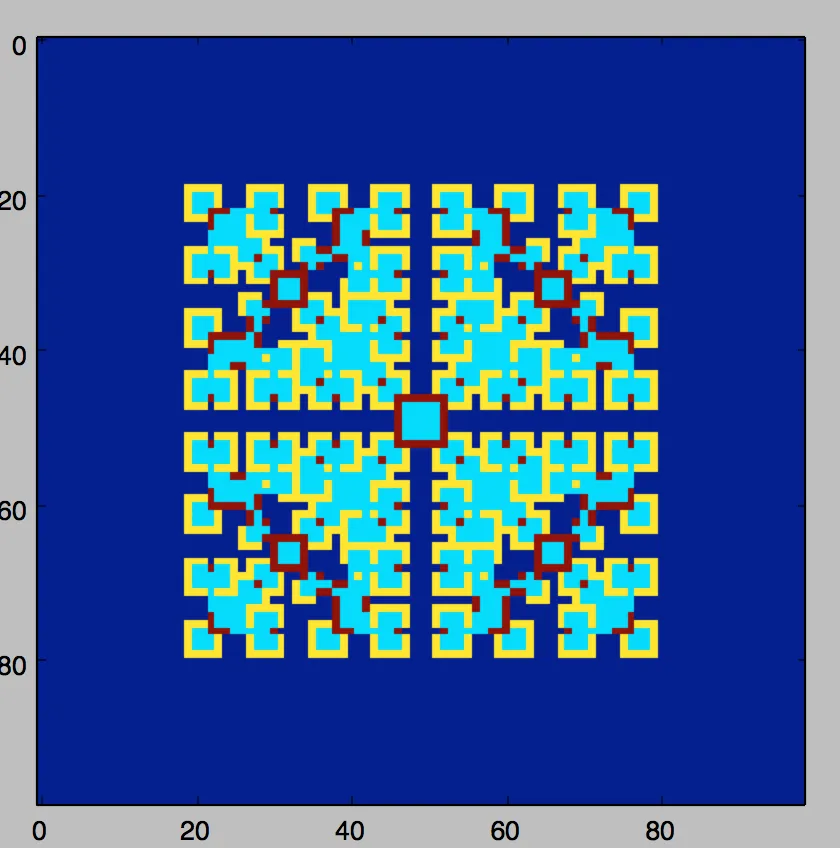我尝试过的主要方法(也是我遇到困难的主要领域)是通过下面展示的replace_pop函数。每轮之后,程序循环遍历网格,并用得分更高的邻居对象替换任何节点上的对象。我认为这应该已经足够了,但是即使经过几代之后,可以看出存在某种形式的复制,但并不是按照应该发生的方式,这使得很难确定究竟出了什么问题。在N = 1(N是代数)时,结果似乎是正确的,因为相邻(邻居是左边,右边,上面和下面)的合作者变成了背叛者,但是随着N变得更大,图像就会迷失方向。
我还重新初始化了每个对象的分数,以确保可以进行适当的复制。但是如果不这样做,则人口将以与上述N = 1情况相同的方式演变,但对于所有后续世代都是如此,这很奇怪,因为应该有比周围合作者分数更高的背叛者。我不知道我哪里错了?我的代码如下(抱歉包含所有代码,但我不知道问题具体出在哪里)。我对Python和Stack非常陌生,所以任何帮助都将不胜感激。
import random
import matplotlib.pyplot as plt
row = 99
col = 99
class Cooperator:
def __init__(self):
self.score = 0
self.id = 'C'
class Defector:
def __init__(self):
self.score = 0
self.id = 'D'
class Grid:
def __init__(self, rowsize, colsize):
self.rowsize = rowsize
self.colsize = colsize
def make_grid(self):
n = self.rowsize
m = self.colsize
arr = [[0 for j in range(m)] for i in range(n)]
return arr
def populate_grid(self):
empty_grid = self.make_grid()
for i in range(self.rowsize):
for j in range(self.colsize):
empty_grid[i][j] = Cooperator()
empty_grid[i//2][j//2] = Defector()
return empty_grid
def shuffle_population(self):
populated_grid = self.populate_grid()
for i in range(self.rowsize):
random.shuffle(populated_grid[i])
return populated_grid
def von_neumann_neighbourhood(array, row, col, wrapped=True):
"""gets von neumann neighbours for a specfic point on grid with or without wrapping"""
neighbours = []
#conditions for in bound points
if row + 1 <= len(array) - 1:
neighbours.append(array[row + 1][col])
if row - 1 >= 0:
neighbours.append(array[row - 1][col])
if col + 1 <= len(array[0]) - 1:
neighbours.append(array[row][col + 1])
if col - 1 >= 0:
neighbours.append(array[row][col - 1])
#if wrapped is on, conditions for out of bound points
if row - 1 < 0 and wrapped == True:
neighbours.append(array[-1][col])
if col - 1 < 0 and wrapped == True:
neighbours.append(array[row][-1])
if row + 1 > len(array) - 1 and wrapped == True:
neighbours.append(array[0][col])
if col + 1 > len(array[0]) - 1 and wrapped == True:
neighbours.append(array[row][0])
return neighbours
def play_round(array, row, col):
b = 1.70
player = array[row][col]
neighbours = von_neumann_neighbourhood(array, row, col)
for neighbour in neighbours:
if player.id == 'C' and neighbour.id == 'C':
player.score += 1
neighbour.score += 1
if player.id == 'D' and neighbour.id == 'D':
player.score += 0
neighbour.score += 0
if player.id == 'D' and neighbour.id == 'C':
player.score += b
neighbour.score += 0
if player.id == 'C' and neighbour.id == 'D':
player.score += 0
neighbour.score += b
def replace_pop(array, row, col):
neighbour_score = 0
type_neighbour = ""
neighbours = von_neumann_neighbourhood(array, row, col)
player_score = array[row][col].score
for neighbour in neighbours:
if neighbour.score > neighbour_score:
neighbour_score = neighbour.score
type_neighbour = neighbour.id
if player_score < neighbour_score:
if type_neighbour == "C":
array[row][col] = Cooperator()
if type_neighbour == "D":
array[row][col] = Defector()
N = 1
last_gen = []
def generations(N, row, col, array):
for gen in range(N):
for z in range(row):
for x in range(col):
play_round(array, z, x)
for r in range(row):
last_gen.append([])
for c in range(col):
last_gen[r].append(lattice[r][c].id)
replace_pop(array, r, c)
for obj in lattice:
for ob in obj:
ob.score = 0
lattice = Grid(row, col).populate_grid()
generations(N, row, col, lattice)
heatmap_stuff = []
for z in range(row):
heatmap_stuff.append([])
for v in range(col):
if lattice[z][v].id == 'C' and last_gen[z][v] == 'C':
heatmap_stuff[z].append(1)
if lattice[z][v].id == 'D' and last_gen[z][v] == 'D':
heatmap_stuff[z].append(0)
if lattice[z][v].id == 'C' and last_gen[z][v] == 'D':
heatmap_stuff[z].append(3)
if lattice[z][v].id == 'D' and last_gen[z][v] == 'C':
heatmap_stuff[z].append(4)
plt.imshow(heatmap_stuff, interpolation='nearest')
plt.colorbar()
plt.show()
编辑:我根据Ilmari的建议更新了代码。虽然结果看起来更好,在实时返回一个真实的分形的同时,结果仍然不理想,这让我认为可能存在其他bug,因为单元格似乎更新正确。下面是我添加/替换到以前代码中的更新代码。
def get_moore_neighbours(grid, row, col):
neighbours = []
for x, y in (
(row - 1, col), (row + 1, col), (row, col - 1),
(row, col + 1), (row - 1, col - 1), (row - 1, col + 1),
(row + 1, col - 1), (row + 1, col + 1)):
if not (0 <= x < len(grid) and 0 <= y < len(grid[x])):
# out of bounds
continue
else:
neighbours.append(grid[x][y])
return neighbours
def calculate_score(grid, row, col):
b = 1.85
player = grid[row][col]
neighbours = get_moore_neighbours(grid, row, col)
for neighbour in neighbours:
if player.id == 'C' and neighbour.id == 'C':
player.score += 1
neighbour.score += 1
if player.id == 'D' and neighbour.id == 'D':
player.score += 0
neighbour.score += 0
if player.id == 'D' and neighbour.id == 'C':
player.score += b
neighbour.score += 0
if player.id == 'C' and neighbour.id == 'D':
player.score += 0
neighbour.score += b
return player.score
def best_neighbor_type(grid, row, col):
neighbour_score = 0
type_neighbour = ""
neighbours = get_moore_neighbours(grid, row, col)
player_score = grid[row][col].score
for neighbour in neighbours:
if neighbour.score > neighbour_score:
neighbour_score = neighbour.score
type_neighbour = neighbour.id
if player_score < neighbour_score:
if type_neighbour == "C":
return 'C'
if type_neighbour == "D":
return 'D'
if player_score >= neighbour_score:
return grid[row][col].id
N = 15
heatmap_data = Grid(row, col).make_grid()
lattice = Grid(row, col).populate_grid()
dbl_buf = Grid(row, col).populate_grid()
for gen in range(N):
for r in range(row):
for c in range(col):
lattice[r][c].score = calculate_score(lattice, r, c)
for r in range(row):
for c in range(col):
dbl_buf[r][c].id = best_neighbor_type(lattice, r, c)
for r in range(row):
for c in range(col):
if lattice[r][c].id == 'C' and dbl_buf[r][c].id == 'C':
heatmap_data[r][c] = 1
if lattice[r][c].id == 'D' and dbl_buf[r][c].id == 'D':
heatmap_data[r][c] = 2
if lattice[r][c].id == 'C' and dbl_buf[r][c].id == 'D':
heatmap_data[r][c] = 3
if lattice[r][c].id == 'D' and dbl_buf[r][c].id == 'C':
heatmap_data[r][c] = 4
plt.imshow(heatmap_data, interpolation='nearest')
plt.pause(0.01)
(lattice, dbl_buf) = (dbl_buf, lattice)
plt.show()

lattice[r][c].id = best_neighbor_type(dbl_buf, r, c)而不是dbl_buf[r][c].id = best_neighbor_type(lattice[r][c], r, c)时,分形似乎更接近于论文中的分形,即使后者更有意义? - Sasquatchcalculate_score()实现中有一些错误。请参见上面的附录。 - Ilmari Karonen